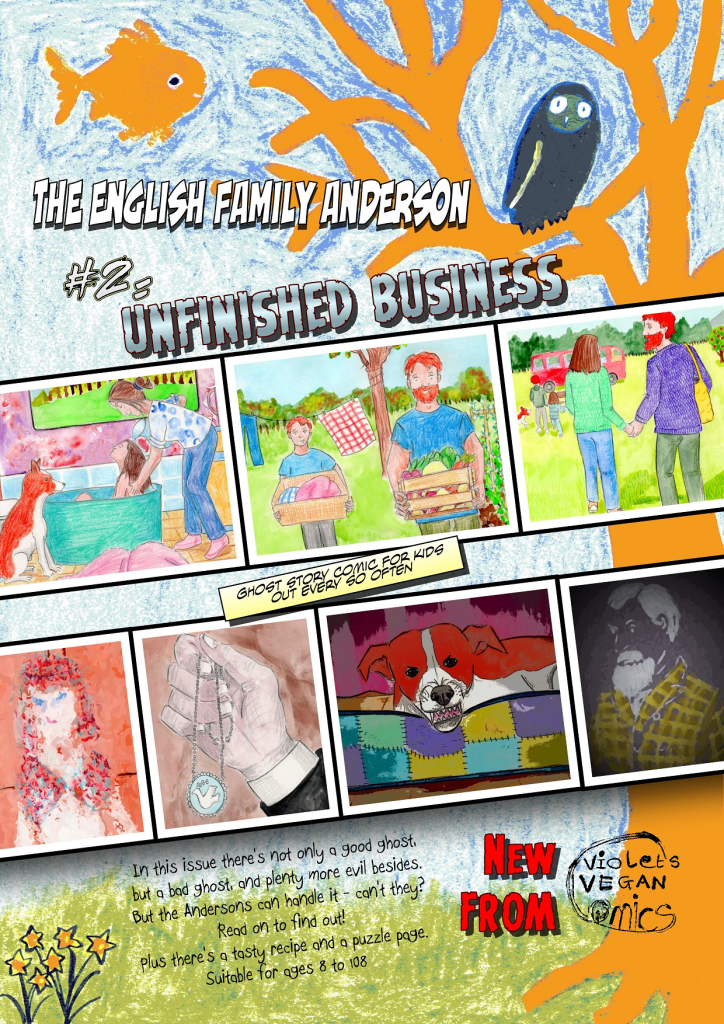Vegan children’s comic, The English Family Anderson, continues here. Click back to Chapter 1, Chapter 2 and Chapter 3

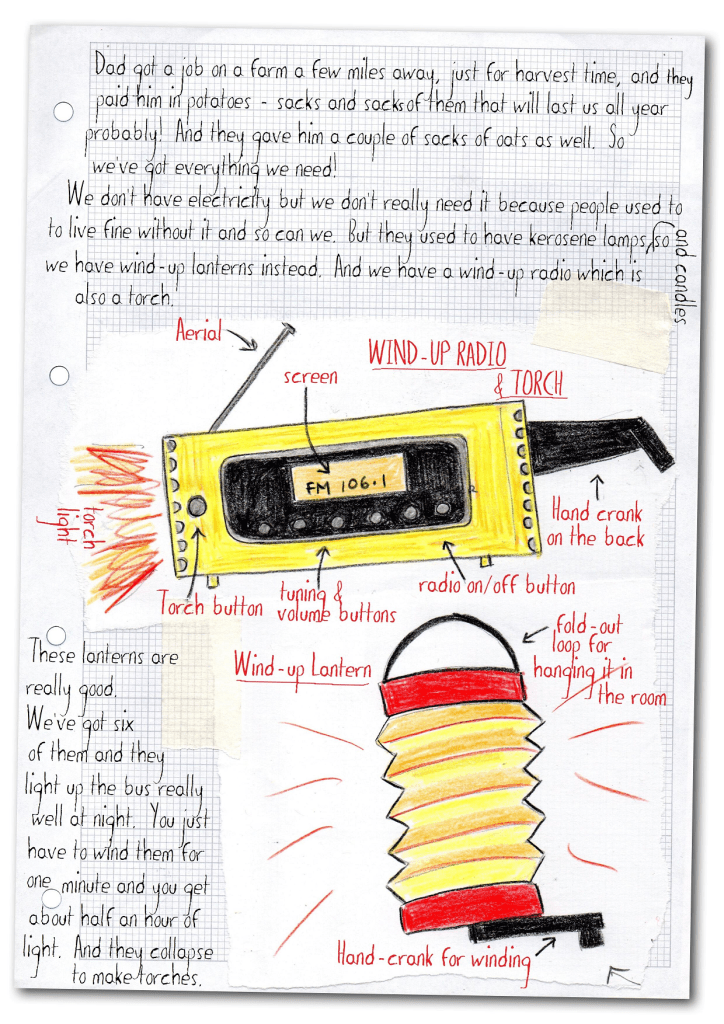
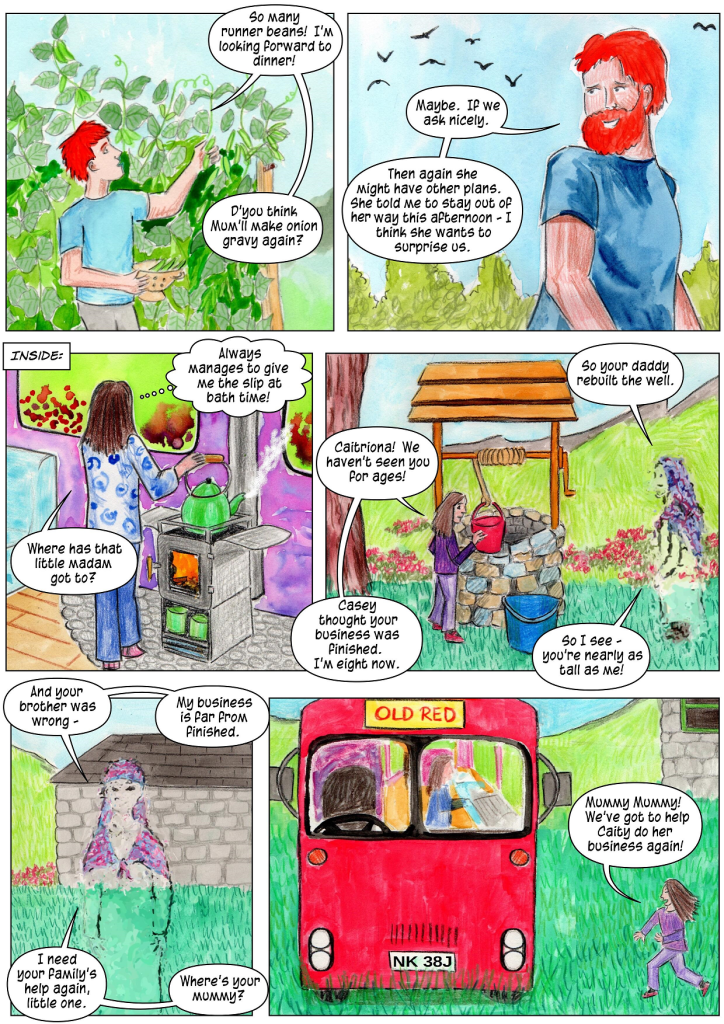

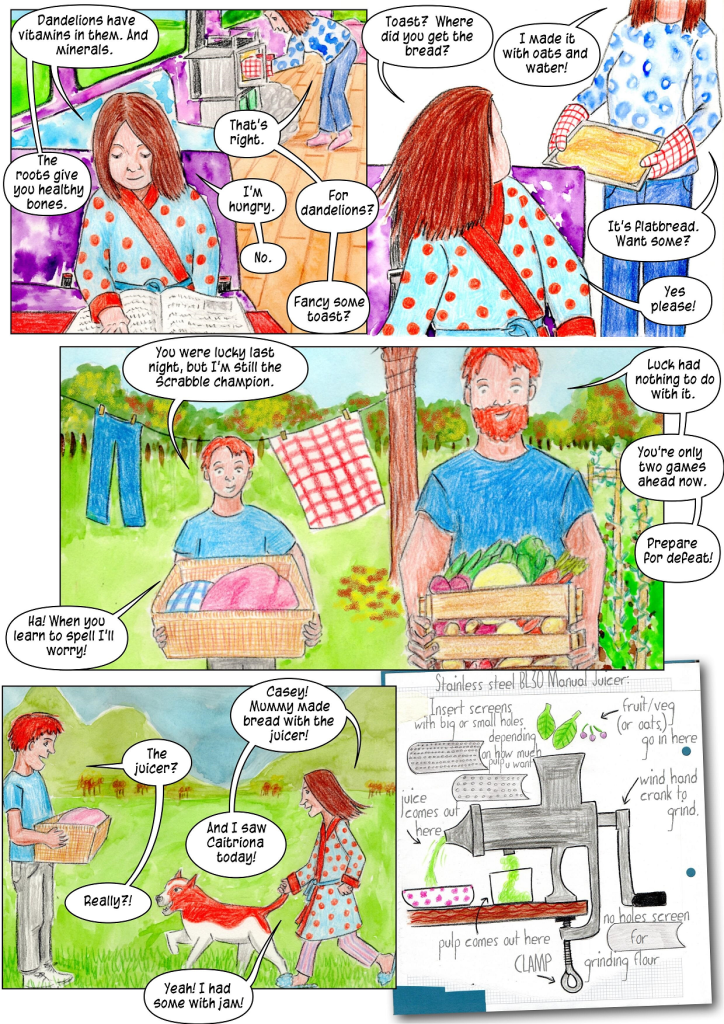



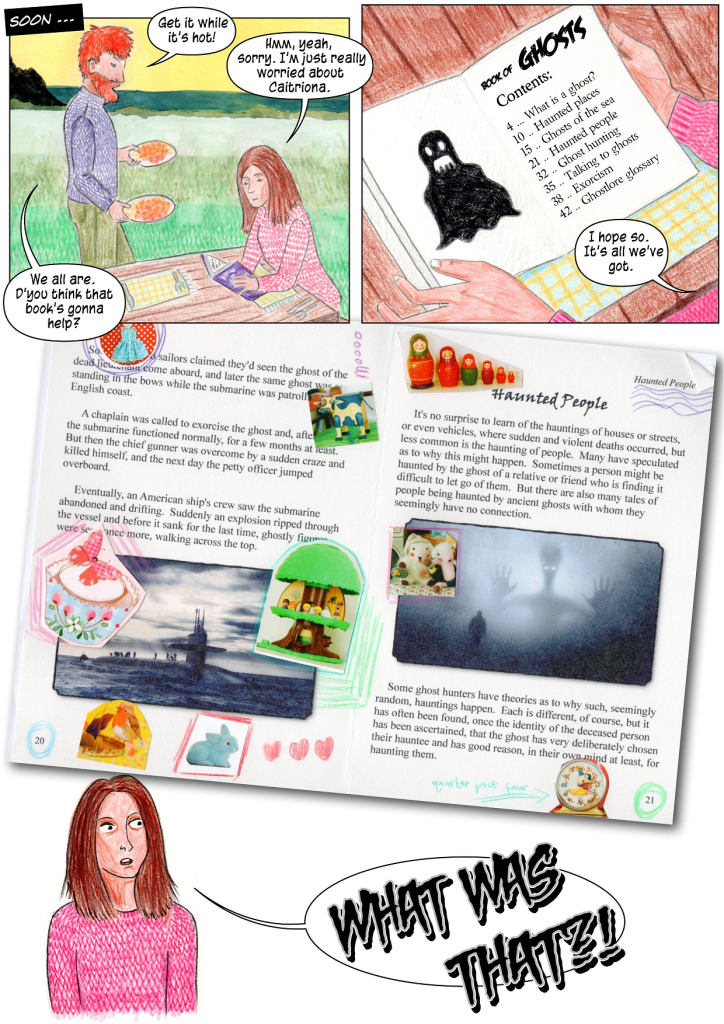












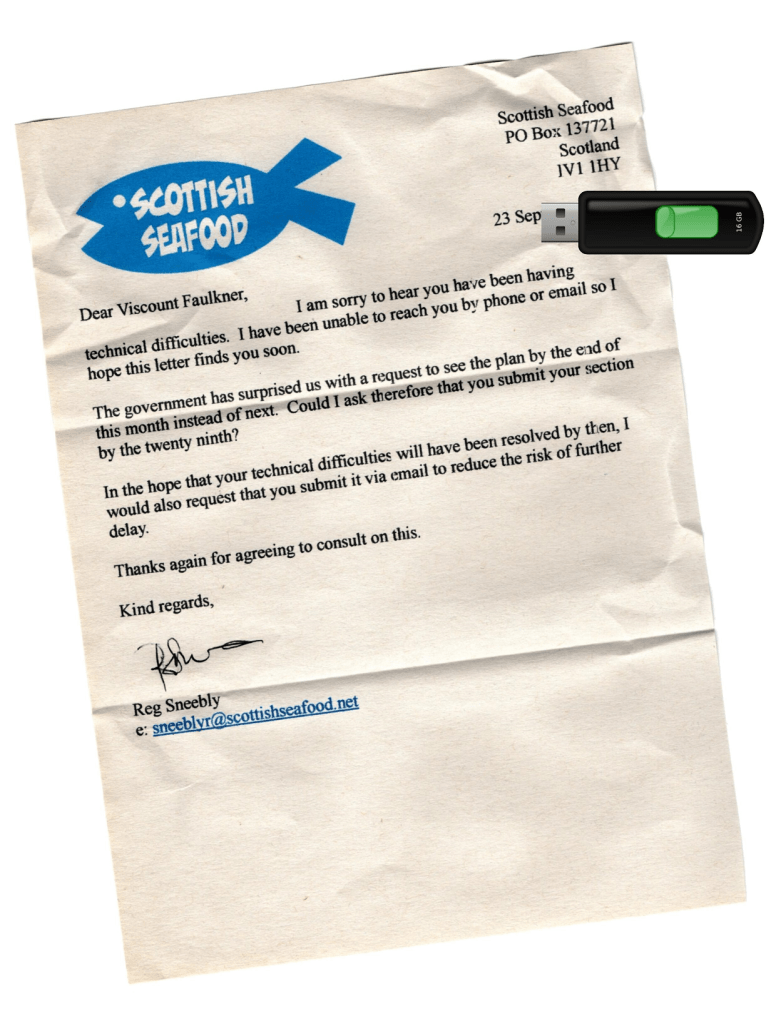

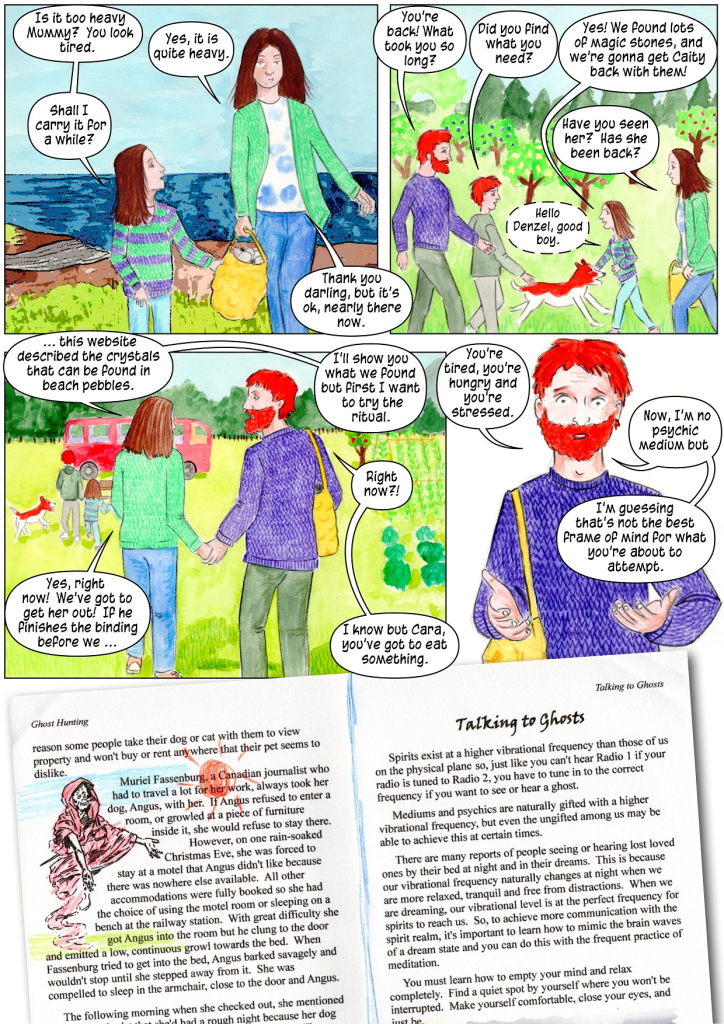





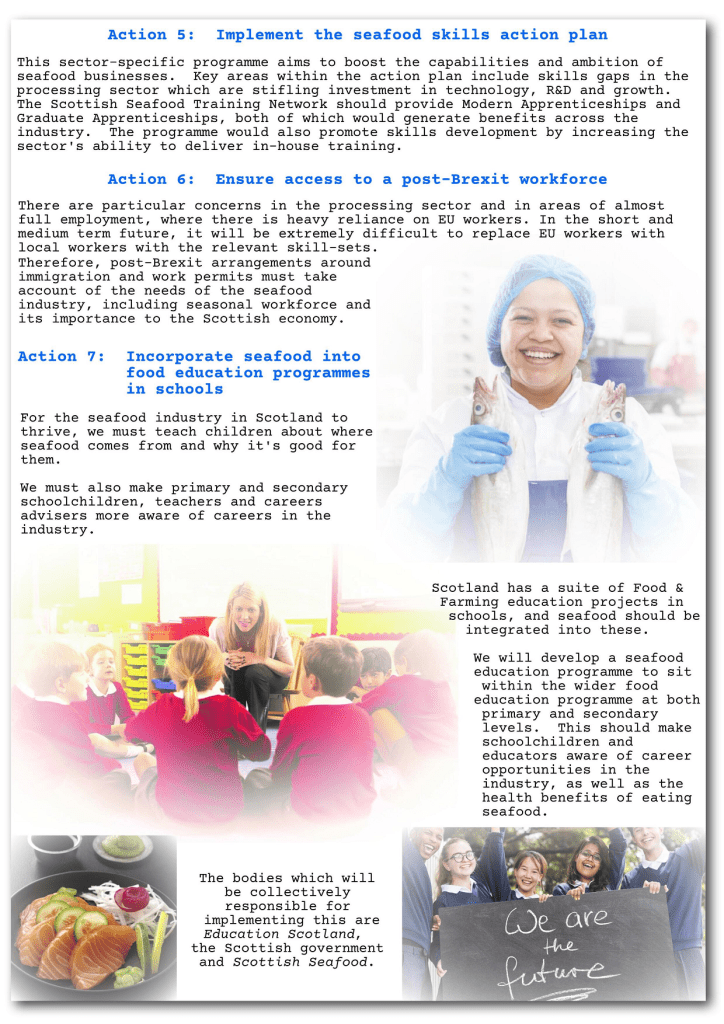







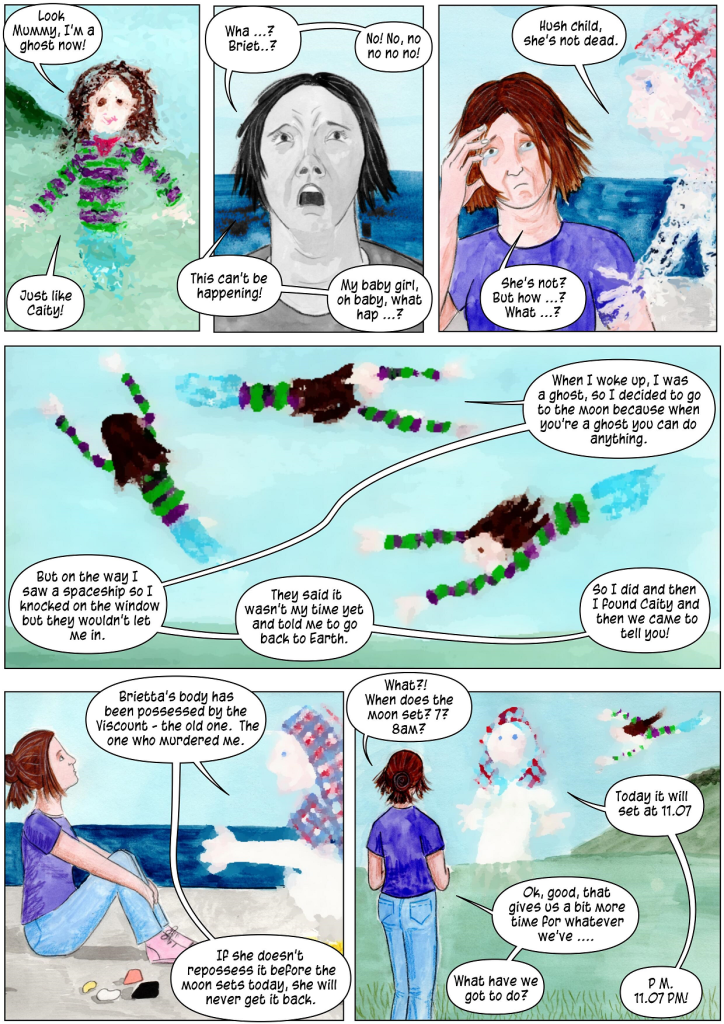
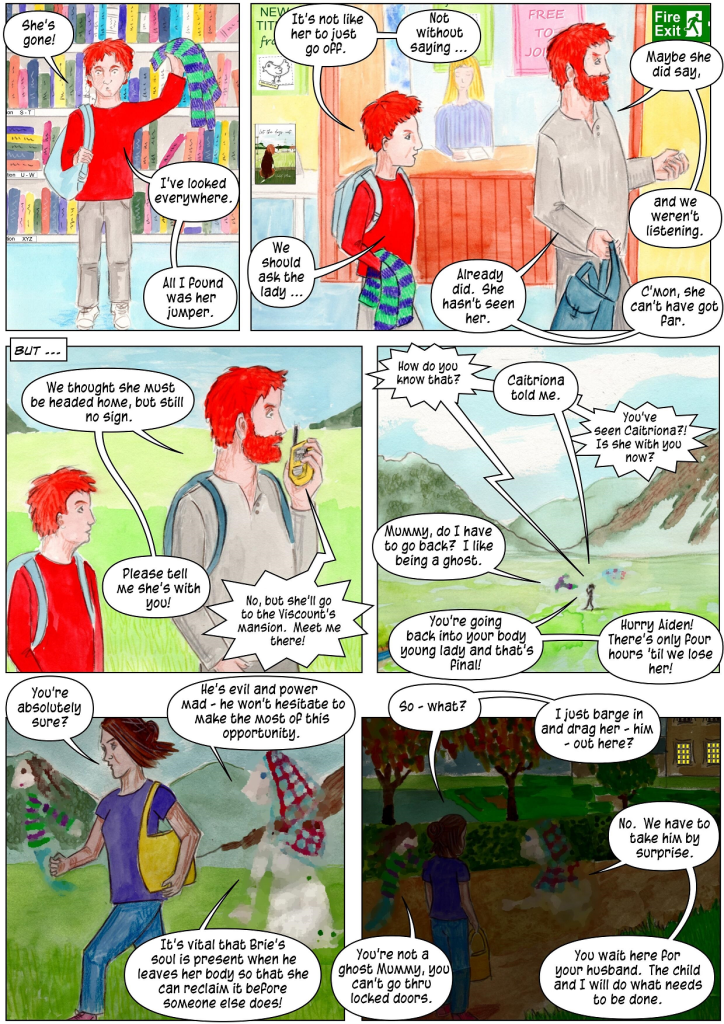




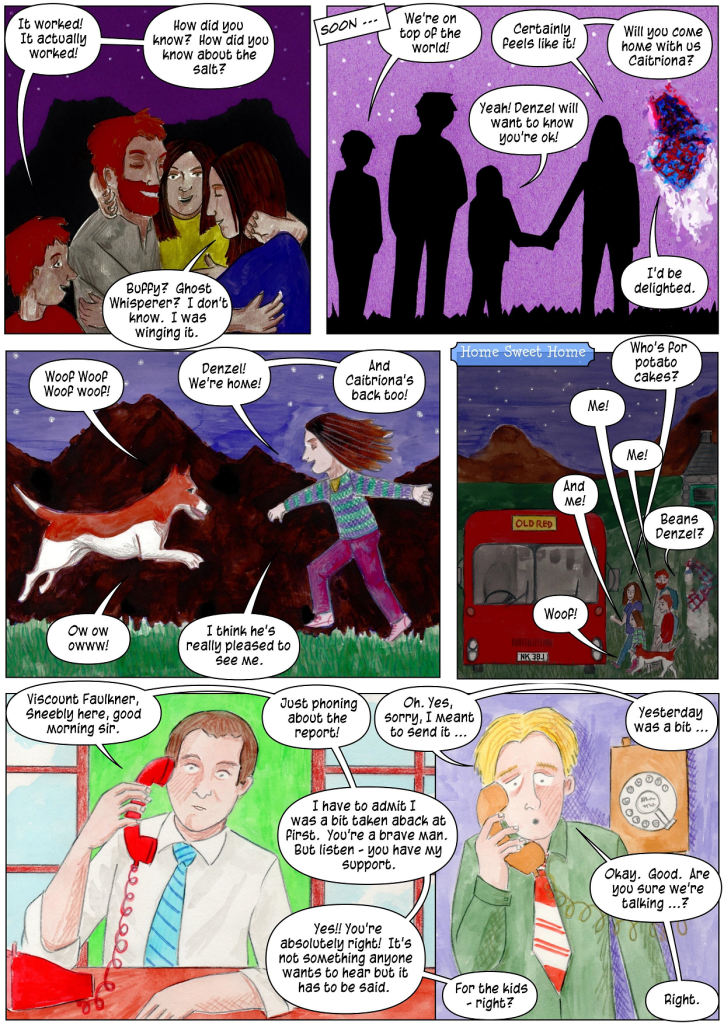






************************************************
The English Family Anderson #2: Unfinished Business is available in paperback from our little shop 😀
***************************************************
[The fictional Turning Tides: A Strategy for Scotland’s Seafood Industry [written by Viscount Faulkner] is based on the real strategic report of Seafood Scotland, Changing Tides – a strategy for Scotland’s seafood industry. I have included exact or paraphrased sections from the 20-page report and just a few of the graphics (this is permitted under copyright law as it is done for criticism and the report is already available to the public). You can download the whole shocking thing here.]
Thanks to photographers at pixabay.com and pexels.com for the images in the reports that were not taken from Changing Tides. Ancient Briton Fishing illustration by Duncan1890 from iStock by Getty Images.
****************************************
The English Family Anderson, chapter 4: Unfinished Business
a vegan children’s comic by Violet Plum, copyright 2021
****
This comic was create with Comic Life by Plasq
SOURCES:
https://www.seafoodscotland.org/changing-tides-to-drive-scotlands-seafood-growth-ambitions/ – accessed 12.4.2021
“There is a £30 billion prize out there by 2030 for Scottish food and drink. This new vision and roadmap for our seafood industry will mean it plays one of the most significant roles in unlocking that huge opportunity.” James Withers, Chief Executive of Scotland Food & Drink.
http://seafoodscotland.org/wp-content/uploads/2019/05/Changing-Tides-_FINAL_PAGES.pdf – accessed 12.4.2021
“ACTION 11:
INCORPORATE SEAFOOD INTO FOOD EDUCATION PROGRAMMES IN SCHOOLS
For the seafood industry in Scotland to thrive, we must teach children about where seafood comes from and why it’s good for them. We must also make primary and secondary school children, teachers and careers advisers more aware of careers in the industry.
With funding for the Seafood in Schools programme now ended, there are fewer opportunities to do either of these. Scotland does have a suite of food & farming education projects in schools, and seafood should be integrated into these. We will develop a seafood education programme to sit
within the wider food education programme, at both primary and secondary levels. This should make schoolchildren and educators aware of career opportunities in the industry, as well
as the health benefits of eating seafood.
Responsible: Education Scotland, Scottish Government, Seafood Scotland.
https://www.pressandjournal.co.uk/fp/news/aberdeen-aberdeenshire/1520325/new-figures-show-fishermen-six-times-more-likely-to-die-at-work/ – accessed 12/4/2021
“New figures have revealed that fishermen face a risk of death six times higher than the most dangerous jobs on land, confirming the profession as the UK’s “most fatal”.
https://www.researchgate.net/publication/47451269_Review_of_Occupational_Hazards_Associated_With_Aquaculture [fish farming] – accessed 14/10/2021
“Aquaculture is an emerging sector that is associated with most of the same hazards that are present in agriculture generally, but many fish farming tasks entail added danger, including working around water and working at night. … In this review, causes of death included drowning, electrocution, crushing-related injury, hydrogen sulfide poisoning, and fatal head injury. Nonfatal injuries were associated with slips, trips, and falls; machines; strains and sprains; chemicals; and fires. Risk factors included cranes (tip over and power line contact), tractors and sprayer-equipped all-terrain vehicles (overturn), heavy loads (lifting), high-pressure sprayers, slippery surfaces, rotting waste (hydrogen sulfide production), eroding levees (overturn hazard), storm-related rushing water, diving conditions (bends and drowning), nighttime conditions, working alone, lack of training, lack of or failure to use personal flotation devices, and all-terrain vehicle speeding. Other hazards included punctures or cuts from fish teeth or spines, needlesticks, exposure to low temperatures, and bacterial and parasitic infections.”
https://www.ebrd.com/downloads/policies/environmental/fish.pdf – accessed 12/5/2021
From the European Bank for Reconstruction and Development
[Regarding workers in fish processing facilities:]
“Manual Handling
Lifting, repetitive work and posture injuries occur as a result of working in the fish processing
industry (e.g. lifting boxes of fishes and repetitive cutting operations). Repetitive tasks can lead to
musculoskeletal injuries.
Electric Shock and Equipment Safety
The use of electrical devices in the fish processing facility (pumping facilities and lighting operations) means that the risk of electrical shock is present during a variety of operations. The use of knives and other sharp tools presents a physical hazard.
Slips and Trips
The wet environment in fish processing facilities means that there is a high risk of slips, trips and
falls near any wet areas or areas of spillage.
Infections and Allergic Reactions
The workforce involved in the handling of fish and shellfish may develop infections and or allergies resulting from the direct exposure to fish. Additionally within contained facilities, water-spraying techniques may result in the inhalation of associated bacteria other foreign material containing disease.
Air Emissions
Attention should be paid to the operation and monitoring of smoking units, boilers and engines.
Such units may have the potential for creation of atmospheric emission problems relating to organic
compounds and particulates. Within processing areas, respiratory illnesses have been known to
occur in workers.
Extreme Temperature Exposure
Fish processing is often undertaken in temperature extremes, therefore appropriate clothing and PPE is required. Exposure to such conditions can aggravate existing physical conditions.
Chemical Exposure
The variety of chemicals used in the cleaning process leads to the potential exposure to hazardous substances (e.g. chlorine and acids). As part of the smoking process, employees may become exposed to carcinogens which are hazardous.
Depending on the location of the facility and the surrounding land use, financial liabilities relating to odour may be a significant factor for fish processing facilities.”
https://www.pcrm.org/search?keys=fish – accessed 30.9.21
See HEALTH CONCERNS ABOUT FISH factsheet:
“Experts agree that fish are the unfortunate victims of our polluted waters. Mercury, a toxic heavy metal, is the primary concern related to fish consumption. A recent study found that as much as 84 percent of the world’s fish contains unsafe levels of mercury. According to a 2013 report by the United Nations, mercury emissions are rising all around the world, making this a global health problem. Even global warming gets some of the blame, with warmer temperatures leading to higher mercury levels in fish. As mercury levels rise across the globe and the toxin accumulates in the fat cells of fish, eating them is becoming increasingly risky. There are several concerns with ingesting mercury. Exposure to the heavy metal has been linked to increased risk for diseases such as cancer and diabetes as well as to short- and long-term problems with the heart, blood vessels, brain, and nerves. Exposure is an even greater concern for pregnant women, as mercury can cross the placenta and accumulate in baby’s tissues, slowing down its brain development.”
“While the consumption of fish and omega-3 fatty acids, including docosahexaenoic acid (DHA) and eicosapentaenoic acid (EPA), has been associated with decreased risk of heart attack in individuals consuming a Western-style diet, recent studies have shown that mercury exposure may produce the opposite effect. … Because mercury accumulates in our tissues, including the heart tissue, consumption of this neurotoxin increases the risk for high blood pressure, irregular and increased heart rate, and death from heart attack or stroke. In addition to mercury, there are other pollutants that accumulate in fish and shellfish. Mercury, dichlorodiphenyltrichloroethane (DDT), polychlorinated biphenyls (PCBs), chlordane, and dioxins account for most fish advisories issued by the EPA. These pollutants accumulate in our body over a lifetime and can lead to problems including poor brain development, liver damage, and disruption of the immune system. Many of these chemicals are especially problematic because they are not readily cleared from the body. Thus, even if exposure is limited to a short period of time, the potential risks can last a lifetime.”
“High levels of toxins, fat, and cholesterol along with a lack of fiber make fish a poor dietary choice. However, fish oils, especially taken as a supplement, have been popularized to treat everything from heart problems to arthritis. Though ingesting fish oil in supplement form eliminates some of the health concerns associated with eating fish, current research shows there may not be any benefits to taking the supplement. According to a review that combined data from 20 studies, the use of omega-3 supplements over a two-year period had no effect on heart-related death, heart attack, or stroke. A second review of 14 studies found similar results – fish oil supplements did not protect people already diagnosed with heart disease from a second heart attack or a related illness. The same lack of protection holds true when looking specifically at people with type 2 diabetes who take fish oil supplements. Instead of supplementing omega-3 fats from fish oil, supplementing from a plant-based source like walnuts and chia seeds may offer actual protection from heart problems. Fish oil supplements have also been touted for brain health; however, according to a 2012 study, no link was found between supplementation and prevention of Alzheimer’s disease. For patients already diagnosed with Alzheimer’s disease, supplementation did not slow mental decline. In fact, one study shows that higher levels of the omega-3 fats EPA and DHA in the blood are actually associated with increased mental decline. In a 2013 study published by the National Cancer Institute, researchers found that men with higher levels of omega-3 fatty acids in their body from supplementing with fish oil had a higher chance of developing prostate cancer and also of developing a worse form of the disease. There has been some debate about whether fish oil supplements are helpful in pregnancy. A 2017 study showed that fish oil supplementation does not help to decrease postpartum depression in Japanese women who frequently eat fish, nor was it found in a second study to improve mental function of the baby. Although the omega-3 fatty acid DHA is important in the development of the brain and eyes, adding it to baby formula was found to provide no benefit to the physical, visual, or mental outcomes of infants born at term.”
“Health Facts
There are better ways to reap the health benefits that are commonly associated with eating fish. It is already proven that plant-based diets help prevent, and even reverse, heart disease. Additionally, fiber reduces cholesterol levels, and fish contain no fiber. When individuals switch to a high-fiber, low-fat diet, their blood cholesterol levels often drop dramatically. Instead of resorting to fish or fish oil as a source of omega-3s, these fatty acids can be found in a more stable form, alpha-linolenic acid (ALA). ALA is the only essential omega-3 fatty acid, meaning it’s the only one that the body cannot make itself and therefore, must be consumed. This fat is concentrated in flaxseeds, walnuts, chia seeds, hemp seeds, soybeans, and wheat germ. The body naturally converts ALA to the longer chain omega-3 fatty acids EPA and DHA. Studies have shown that the conversion rate of ALA to EPA and DHA is sufficient for obtaining proper amounts of these longer chain fatty acids. In fact, results from the European Prospective Investigation into Cancer and Nutrition (EPIC) trials suggest women on vegan diets have more omega-3s in their blood compared with fish-eaters, meat-eaters, and lacto-ovo vegetarians. Thus, for those who do not consume fish, the conversion rate of ALA to EPA and DHA may increase naturally to allow for the adequate supply of these fatty acids.”
“By focusing on plant foods like vegetables, fruits, whole grains, beans, peas, nuts, and seeds, one can get the full range of essential nutrients without the toxins and other health risks associated with fish consumption.”
For those who still want omega 3 supplements, that’s no problem!
https://www.nothingfishy.co/pages/about-algae-omega-3-dha – accessed 12.4.2021
“What is algae?
Microalgae is one of the Earth’s oldest plant organisms. It survives by converting the sun’s rays into a viable form of energy. Not only is algae an integral part of the marine food chain, but it also produces many natural nutrients that are essential for human well-being.
Algae live in water but the human eye can only see them when they are in large concentrated groups – the water will then shimmer with their colour. Billions of years ago, algae started the process of photosynthesis (converting sunlight and carbon dioxide into oxygen). Over 70% of the oxygen that we breathe today comes from the algae in the oceans. [NB All seaweed is algae but not all algae is seaweed.]
As algae form the basis of the food chain in the ocean, lots of the nutrients from the algae gets passed down into other marine life forms. For example, fish themselves do not produce Omega 3, but rather they eat krill that have eaten algae. With recent technological innovations, it’s no longer required to catch and kill fish for Omega 3, we can ‘cut out the middleman’ and extract the nutrients from the algae itself.
Omega 3 from algae versus fish:
Heavy metals, PCBs (polychlorinated biphenyls) and other nasty stuff has been found at dangerous levels in fish oil. Unfortunately, lots of pollution in the ocean sometimes leaves the fish with harmful levels of poisonous compounds; levels of sea mercury have increased by 30% over the last 30 years alone. This mercury is almost impossible to remove from the fish when extracting the fish oil. Whether you’re pregnant or you are just careful about what you eat, algae is the cleanest source of Omega 3 available.
Around 85% of global fish stocks are being over exploited. The growth of the Omega 3 market worldwide is a direct contributor to both illegal fishing and overfishing. As with all ecological food chains, a lot of damage can be done to all species by removing large numbers of one species. Our algae is grown in a controlled environment in a sustainable way. It’s therefore environmentally sustainable.”
It’s vegan and vegetarian-friendly. It also contains docosaheaenoic acid (DHA), which is only present in marine-based life forms.”
https://www.nationalfoodstrategy.org/wp-content/uploads/2021/07/National-Food-Strategy-The-Plan.pdf – [government consultation] accessed 15.7.21
“In July of last year, I published Part One of the National Food Strategy, a Government-commissioned independent review into the food system. This had originally been intended as a broad analysis of the strengths and flaws of the entire food system from farm to fork, with Part Two following on behind with recommendations. But COVID-19 intervened, and Part One became instead an urgent response to the issues of hunger and ill-health raised by the pandemic, as well as the trade and food standards issues created by the end of the EU Exit transition period,” wrote Henry Dimbleby in his introduction to the report. “The food system we have now has evolved over many years. It won’t be easy to reshape it. But time is not on our side. The effects of climate change are already becoming apparent around the world. Diet-related disease is putting an intolerable strain on our nation’s health and finances – and COVID-19 has only increased the pressure. For our own health, and that of our planet, we must act now.”
From the Executive Summary: “But the food we eat – and the way we produce it – is doing terrible damage to our planet and to our health. The global food system is the single biggest contributor to biodiversity loss, deforestation, drought, freshwater pollution and the collapse of aquatic wildlife. It is the second-biggest contributor to climate change, after the energy industry.”
“Because there is a bigger market for unhealthy food, companies invest more into developing and marketing it. This in turn expands the market further still. The bigger the market, the greater the economies of scale. We have become trapped in a vicious circle – the Junk Food Cycle. The consequences for our health are devastating. … Four out of the top five [health] risk factors are diet related.”
“This plague of dietary ill-health crept up on us slowly, without generating much public uproar. But the COVID-19 pandemic has provided a painful reality check.”
“The UK now has a once-in-a-lifetime opportunity to reshape the food system. The pandemic has created a momentum for change – in Government and in industry [really?], as well as among the public. There is widespread recognition that we need to change our national diet as a matter of urgency.”
“… our current appetite for meat is unsustainable: 85% of farmland is used to feed livestock. We need some of that land back.”
https://www.gov.uk/government/statistics/farming-statistics-provisional-crop-areas-yields-and-livestock-populations-at-1-june-2021-united-kingdom – accessed 14.10.2021
The following excerpts are from the above report :
“Agricultural land and arable crop areas
The total utilised agricultural area (UAA) in the UK has decreased by 0.8%, to just over 17.1 million hectares.
Horticultural crops
In 2021 the total area of horticultural crops [fruit and vegetables] decreased by 3.1% to 161 thousand hectares.”
[Potatoes, mentioned later in the report, are stated to cover another 137 thousand hectares, giving a total area for fruit and vegetables of 298 000 hectares].
[ Let me explain using the three line method:
17 100 000 hectares = 100% of utilised agricultural land in the UK
Therefore 1 hectare = 100 divided by 17 100 000 = 0.00000585% of utilised agricultural land
So 298 000 hectares = 0.00000585 multiplied by 298 000
= 1.74 % of UK agricultural land is used to grow fruit and vegetables for humans! ]
https://pranarun.org/catch-and-release-fishing-does-not-hurt-fish/ – accessed 15.10.21 [Heading of a post which denies that claim]
“Encouraging children to fish not only encourages animal cruelty, but also exposures the child to emotional and psychiatric trauma. Deborah Kay Steinken (an animal rights activist, reporter, and domestic violence counselor) describes, “Children who witness cruelty to animals experience psychological and emotional damage that compromises their empathy development because they become desensitized to feelings of kindness, hurt, pain, and suffering in themselves and other living beings.”
“Fishing not only harms fish, but lost lines and hooks can be a life threatening hazard to any animal. Fishing lines can wrap around birds, turtles, and other animals and can become embedded in their skin which can cause injury, infection or death. Hooks can catch on to any object, impaling anything that mistakenly comes across it – whether that be domestic pets, wild animals or even people.
“In no way is catch-and-release fishing humane, but there are plenty of ways to connect with nature and water. Instead of fishing, try meditation or reading a book by the water, or relaxing water sports like kayaking, canoeing or boating. Experience and enjoy marine life by snorkeling and scuba diving. Nothing beats enjoying nature by viewing animals in their natural environment.” [without disturbing them or worrying them].
https://sentientmedia.org/fish-farming/ – accessed 24.6.21
“Marco Vindas, the lead author of the study, says that “fish are capable of complex behavior and their brain system has a lot of similarities with that of mammals, including humans.”
https://www.all-creatures.org/articles/ar-fish-sentient-emotional.html – accessed 15.10.21
“
- They [fish] develop cultural traditions and can even recognise themselves and others
- They also show signs of Machiavellian intelligence, such as cooperation and reconciliation
- Professor Brown said the primary senses of the fish are ‘just as good’ and in some cases better than that of humans.
- The level of mental complexity that fish display is on a par with most other vertebrates, while there is mounting evidence that they can feel pain in a manner similar to humans. “
https://www.animalaid.org.uk/the-issues/our-campaigns/animal-farming/the-suffering-of-fish/ – accessed 15.10.21
“Aquatic animals have very little protection in law at the time of their slaughter. Killing methods for farmed fish are vicious – some are boiled alive, while others suffer asphyxiation or are bled to death without stunning. This would be considered completely unacceptable for any other kind of animal.
Most wild-caught fish are gutted whilst still alive or are left to suffocate. The whole commercial fishing process, totally ungoverned by humane protocols, let alone laws, could be the greatest animal welfare scandal of our time.
“Studies have shown that crustaceans (including lobsters, crabs and shrimp) as well as cephalopods (including squid and octopus) are just as capable of feeling pain and suffering as other animals.
Crabs, lobsters and prawns are often boiled alive or have their legs ripped off to be sold at markets. Female shrimp on commercial farms have one of their eyestalks sliced off with a razor to ensure they produce more eggs and spawn earlier.”
[NB: No sensible person needs a ‘scientist’ to inject bee venom into a fish’s lips to know that they feel pain. Diabetics have to have their feet checked regularly because they can become numb and get injured without the person knowing. Left untreated, the person’s wound can develop gangrene, resulting in foot amputation. Likewise, any being who didn’t feel pain would not take care to avoid injury and would not long survive. All animals must feel pain. It is essential to their survival.]
https://www.livekindly.co/paul-watson-documentary-save-whales/ – accessed 15.10.21
“The message I try to get across to everybody is very simple,” he continued. “If the oceans die, we all die.”
The concept that the oceans are critical to human survival has long been part of Sea Shepherd’s core message. The oceans are critically important to healthy ecosystems and biodiversity. More than half of the oxygen we breathe is largely due to seaweed or ocean dwellers like phytoplankton — a type of microscopic algae — that photosynthesize. The earliest known ocean photosynthesize is 3.5 billion years old according to Smithsonian, but plankton populations have declined by 40 percent since 1950.
“Every year [more than] 65 billion [land] animals are slaughtered to feed humans and some 40% of all the fish caught are converted to fishmeal to feed pigs, chickens, domestic salmon, fur-bearing animals, and cat food,” Watson wrote in a 2015 Sea Shepherd post. “With fish populations diminishing, the corporations are looking to replace fishmeal with a plankton paste.”
“The fish- and animal-killing industries are robbing the seas of oxygen production for short-term profits,” the Toronto native continued. Other issues contributing to the decline of the ocean’s health include acidification from CO2, pollution, and habitat destruction, and the decline of whales, the primary species that fertilize phytoplankton.
“The reality is that there are simply not enough fish in the sea to continue to feed an ever-expanding human population. It is a simple concept to understand – more humans eating fish, directly or indirectly (i.e. fishmeal), contributes to further diminishment of fish,” he adds.
Watson promotes a vegan diet”
[Sea Shepherd Conservation Society is an international non-profit with a worldwide presence and a mission to protect all marine animals by direct action: https://seashepherd.org/ ]
*******************************

Violet’s Vegan Comics creates funny, enlightening and sometimes action packed vegan children’s books for readers of all ages.
Established 2012

